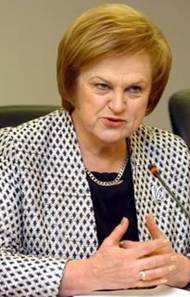
THE VOICE OF INTERNATIONAL LITHUANIA
|
VilNews has its own Google archive! Type a word in the above search box to find any article.
You can also follow us on Facebook. We have two different pages. Click to open and join.
|
![]()

Kazimira Prunskiene
MOSCOW – To a casual observer, Lithuania’s former prime minister Kazimira Prunskiene might seem to be aiming to forge good-neighbourly relations with Russia. In point of fact, this is nothing but a ploy to be able to tap into the funds allocated for the construction of Russia’s Baltic Nuclear Power Plant in Kaliningrad Region.
At the end of May, Prunskiene – currently the leader of Lithuania’s agrarian centre-left party, the Lithuanian Peasant Popular Union, and formerly, this small Baltic republic’s prime minister in 1990 and 1991, was on a visit to Russia’s westernmost enclave of Kaliningrad. The agenda of this trip also included a visit to the site of the Baltic Nuclear Power Plant (NPP), now under construction. During a meeting with Kaliningrad Governor Nikolai Tsukanov, Prunskiene talked about the “necessity” for Lithuania to participate in the construction and operation of the future plant. As she said after the conversation with the governor, she had had the opportunity, while being led around the site, to ascertain for herself the “potential, reliability, and safety of the station.” The interesting fact about this station is that at this point, it presents nothing more than a huge pit awaiting to be filled with concrete for a future foundation. An assessment of reliability of a new nuclear power plant based on a tour around a big empty pit must indeed be a completely novel and unique method in the history of NPP safety evaluations.
What is this new Russian site exactly? The Baltic NPP is being built in Neman in Kaliningrad Region, a small patch of Russian land wedged between the European Union nations of Poland and Lithuania, on the southwest and northeast, respectively, and the Baltic Sea on the west. To the southeast beyond Lithuania is another former Soviet republic, Belarus, and further to the east, the vast expanses of mainland Russia. The two-unit 2.3-gigawatt nuclear power plant built to an experimental Russian design will thus end up being in the very backyard of the European Union, close to the Lithuanian capital, Vilnius, and also one tip of an ominous triangle – Belarus’s project in Ostrovets and Lithuania’s own tentatively planned new NPP in Visaginas being the other two – that environmentalists fear will lock the Baltic region into a desperate nuclear chokehold.
Curiously, the Baltic NPP is also a first Russian NPP project that Moscow has made open to participation by foreign investors – 51 percent of the capital funding is to be provided by the Russian state nuclear corporation Rosatom, while the rest is expected to flow from private coffers based abroad. And the only reason this station is being built is to export the future power output to the European Union – rather than meet the local demand – something that is well confirmed by documents from the Russian electric power trader Inter RAO, which has been charged with finding a European investor for the project.
Read more at: http://www.bellona.org/articles/articles_2011/lith_moscow
- Bookmark :
- Digg
- del.icio.us
- Stumbleupon
- Redit it
VilNews e-magazine is published in Vilnius, Lithuania. Editor-in-Chief: Mr. Aage Myhre. Inquires to the editors: editor@VilNews.com.
Code of Ethics: See Section 2 – about VilNews. VilNews is not responsible for content on external links/web pages.
HOW TO ADVERTISE IN VILNEWS.
All content is copyrighted © 2011. UAB ‘VilNews’.

 Click on the buttons to open and read each of VilNews' 18 sub-sections
Click on the buttons to open and read each of VilNews' 18 sub-sections 


